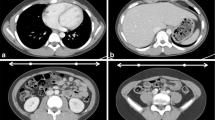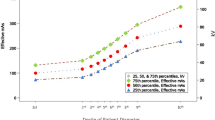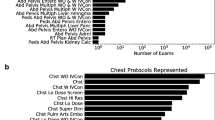Abstract
Background
In children exposed to multiple computed tomography (CT) exams, performed with varying z-axis coverage and often with tube current modulation, it is inaccurate to add volume CT dose index (CTDIvol) and size-specific dose estimate (SSDE) to obtain cumulative dose values.
Objective
To introduce the patient-size-specific z-axis dose profile and its dose line integral (DLI) as new dose metrics, and to use them to compare cumulative dose calculations against conventional measures.
Materials and methods
In all children with 2 or more abdominal-pelvic CT scans performed from 2013 through 2019, we retrospectively recorded all series kV, z-axis tube current profile, CTDIvol, dose-length product (DLP) and calculated SSDE. We constructed dose profiles as a function of z-axis location for each series. One author identified the z-axis location of the superior mesenteric artery origin on each series obtained to align the dose profiles for construction of each patient’s cumulative profile. We performed pair-wise comparisons between the peak dose of the cumulative patient dose profile and ΣSSDE, and between ΣDLI and ΣDLP.
Results
We recorded dose data in 143 series obtained in 48 children, ages 0–2 years (n=15) and 8–16 years (n=33): ΣSSDE 12.7±6.7 and peak dose 15.1±8.1 mGy, ΣDLP 278±194 and ΣDLI 550±292 mGy·cm. Peak dose exceeded ΣSSDE by 20.6% (interquartile range [IQR]: 9.9–26.4%, P<0.001), and ΣDLI exceeded ΣDLP by 114% (IQR: 86.5–147.0%, P<0.001).
Conclusion
Our methodology represents a novel approach for evaluating radiation exposure in recurring pediatric abdominal CT examinations, both at the individual and population levels. Under a wide range of patient variables and acquisition conditions, graphic depiction of the cumulative z-axis dose profile across and beyond scan ranges, including the peak dose of the profile, provides a better tool for cumulative dose documentation than simple summations of SSDE. ΣDLI is advantageous in characterizing overall energy absorption over ΣDLP, which significantly underestimated this in all children.




Similar content being viewed by others
References
Mettler FA Jr, Mahesh M, Bhargavan-Chatfield M et al (2020) Patient exposure from radiologic and nuclear medicine procedures in the United States: procedure volume and effective dose for the period 2006–2016. Radiology 295:418–427
Sodickson A, Baeyens PF, Andriole KP et al (2009) Recurrent CT, cumulative radiation exposure, and associated radiation-induced cancer risks from CT of adults. Radiology 251:175–184
Rehani MM, Yang K, Melick ER et al (2020) Patients undergoing recurrent CT scans: assessing the magnitude. Eur Radiol 30:1828–1836
Rehani MM, Melick ER, Alvi RM et al (2020) Patients undergoing recurrent CT exams: assessment of patients with non-malignant diseases, reasons for imaging and imaging appropriateness. Eur Radiol 30:1839–1846
Brenner DJ, Hricak H (2010) Radiation exposure from medical imaging: time to regulate? JAMA 304:208–209
Zucker EJ, Larson DB, Newman B et al (2015) Radiologist compliance with California CT dose reporting requirements: a single-center review of pediatric chest CT. AJR Am J Roentgenol 204:810–816
American Association of Physicists in Medicine (2011) Report of Task Group 204: Size-specific dose estimates (SSDE) in pediatric and adult body CT examinations. https://www.aapm.org/pubs/reports/rpt_204.pdf. Accessed 6 June 2021
Padole A, Deedar Ali Khawaja R, Otrakji A et al (2016) Comparison of measured and estimated CT organ doses for modulated and fixed tube current: a human cadaver study. Acad Radiol 23:634–642
Samei E, Li X, Chen B, Reiman R (2013) The effect of dose heterogeneity on radiation risk in medical imaging. Radiat Prot Dosim 155:42–58
Tian X, Segars WP, Dixon RL, Samei E (2016) Convolution-based estimation of organ dose in tube current modulated CT. Phys Med Biol 61:3935–3954
Turner AC, Zhang D, Khatonabadi M et al (2011) The feasibility of patient size-corrected, scanner-independent organ dose estimates for abdominal CT exams. Med Phys 38:820–829
McCollough C, Bakalyar DM, Bostani M et al (2014) Use of water equivalent diameter for calculating patient size and size-specific dose estimates (SSDE) in CT. The report of AAPM Task Group 220. https://www.aapm.org/pubs/reports/RPT_220.pdf. Accessed 6 June 2021
American Association of Physicists in Medicine (2010) Report of Task Group 111: Comprehensive methodology for the evaluation of radiation dose in x-ray computed tomography. https://www.aapm.org/pubs/reports/RPT_111.pdf. Accessed 6 June 2021
Dixon RL, Boone JM (2013) Dose equations for tube current modulation in CT scanning and the interpretation of the associated CTDIvol. Med Phys 40:111920
Li X, Yang K, Liu B (2018) Radiation dose dependence on subject size in abdominal computed tomography: water phantom and patient model comparison. Med Phys 45:2309–2317
Li X, Yang K, Liu B (2016) A study of the midpoint dose to CTDIvol ratio: implications for CT dose evaluation. Med Phys 43:5878
Li X, Zhang D, Liu B (2012) Equations for CT dose calculations on axial lines based on the principle of symmetry. Med Phys 39:5347–5352
Li X, Zhang D, Liu B (2014) Radiation dose calculations for CT scans with tube current modulation using the approach to equilibrium function. Med Phys 41:111910
Li X, Yang K, Liu B (2019) Exam-level dose monitoring in CT: quality metric consideration for multiple series acquisitions. Med Phys 46:1575–1580
Li X, Zhang D, Liu B (2012) Estimation of the weighted CTDI(infinity) for multislice CT examinations. Med Phys 39:901–905
Cook TS, Zimmerman SL, Steingall SR et al (2011) RADIANCE: an automated, enterprise-wide solution for archiving and reporting CT radiation dose estimates. Radiographics 31:1833–1846
Cross NM, Zamora DA, Moirano JM et al (2018) Practical CT dose monitoring: current tools and the clinical relevance. Semin Roentgenol 53:115–123
Kanal KM, Butler PF, Sengupta D et al (2017) U.S. diagnostic reference levels and achievable doses for 10 adult CT examinations. Radiology 284:120–133
Brady SL, Mirro AE, Moore BM, Kaufman RA (2015) How to appropriately calculate effective dose for CT using either size-specific dose estimates or dose-length product. AJR Am J Roentgenol 204:953–958
Boone JM (2007) The trouble with CTD100. Med Phys 34:1364–1371
Frush D, Denham CR, Goske MJ et al (2013) Radiation protection and dose monitoring in medical imaging: a journey from awareness, through accountability, ability and action...but where will we arrive? J Patient Saf 9:232–238
Miglioretti DL, Johnson E, Williams A et al (2013) The use of computed tomography in pediatrics and the associated radiation exposure and estimated cancer risk. JAMA Pediatr 167:700–707
Brenner DJ (2012) We can do better than effective dose for estimating or comparing low-dose radiation risks. Ann ICRP 41:124–128
Harrison J, Lopez PO (2015) Use of effective dose in medicine. Ann ICRP 44:221–228
Durand DJ, Dixon RL, Morin RL (2012) Utilization strategies for cumulative dose estimates: a review and rational assessment. J Am Coll Radiol 9:480–485
Balonov MI, Shrimpton PC (2012) Effective dose and risks from medical X-ray procedures. Ann ICRP 41:129–141
McCollough CH, Leng S, Yu L et al (2011) CT dose index and patient dose: they are not the same thing. Radiology 259:311–316
Shrimpton PC, Wall BF, Yoshizumi TT et al (2009) Effective dose and dose-length product in CT. Radiology 250:604–605
Kleinman PL, Strauss KJ, Zurakowski D et al (2010) Patient size measured on CT images as a function of age at a tertiary care children’s hospital. AJR Am J Roentgenol 194:1611–1619
Samei E, Tian X, Segars WP (2014) Determining organ dose: the holy grail. Pediatr Radiol 44:460–467
Rosendahl S, Büermann L, Borowski M et al (2019) CT beam dosimetric characterization procedure for personalized dosimetry. Phys Med Biol 64:075009
Christianson O, Li X, Frush D, Samei E (2012) Automated size-specific CT dose monitoring program: assessing variability in CT dose. Med Phys 39:7131–7139
Li X, Samei E, Segars WP et al (2011) Patient-specific radiation dose and cancer risk for pediatric chest CT. Radiology 259:862–874
Sahbaee P, Segars WP, Samei E (2014) Patient-based estimation of organ dose for a population of 58 adult patients across 13 protocol categories. Med Phys 41:072104
Tian X, Li X, Segars WP et al (2015) Prospective estimation of organ dose in CT under tube current modulation. Med Phys 42:1575–1585
Angel E, Yaghmai N, Jude CM et al (2009) Dose to radiosensitive organs during routine chest CT: effects of tube current modulation. AJR Am J Roentgenol 193:1340–1345
Turner AC, Zankl M, DeMarco JJ et al (2010) The feasibility of a scanner-independent technique to estimate organ dose from MDCT scans: using CTDIvol to account for differences between scanners. Med Phys 37:1816–1825
Zhang D, Cagnon CH, Villablanca JP et al (2012) Peak skin and eye lens radiation dose from brain perfusion CT based on Monte Carlo simulation. AJR Am J Roentgenol 198:412–417
Charles MW (2008) ICRP publication 103: recommendations of the ICRP. Radiat Prot Dosim 129:500–507
Kasraie N, Jordan D, Keup C et al (2018) Optimizing communication with parents on benefits and radiation risks in pediatric imaging. J Am Coll Radiol 15:809–817
Li X, Yang K, Westra SJ et al (2021) Fetal dose evaluation for body CT examinations of pregnant patients during all stages of pregnancy. Eur J Radiol 141:109780
Author information
Authors and Affiliations
Corresponding author
Ethics declarations
Conflicts of interest
None
Additional information
Publisher’s note
Springer Nature remains neutral with regard to jurisdictional claims in published maps and institutional affiliations.
Supplementary Information
Online Supplementary Material 1
Direct calculation versus Monte Carlo simulation of z-axis dose profile (DOCX 16 kb)
Online Supplementary Material 2
Demographics of 15 children under 2 years of age who underwent multiple abdominal CT acquisitions and summated dose descriptors (DOCX 16 kb)
Online Supplementary Material 3
Demographics of 33 children ages 8–16 years who underwent multiple abdominal CT acquisitions and summated dose descriptors (DOCX 19 kb)
Online Supplementary Material 4
Graph displays the profiles of WED (water-equivalent diameter), mA and radiation dose in a 75-year-old woman (height: 163 cm, weight: 48 kg) who underwent contiguous chest and abdominopelvic examinations at 120 kV (beam width: 19.2 mm, helical pitch: 1) (PNG 1037 kb)
Rights and permissions
About this article
Cite this article
Tabari, A., Li, X., Yang, K. et al. Patient-level dose monitoring in computed tomography: tracking cumulative dose from multiple multi-sequence exams with tube current modulation in children. Pediatr Radiol 51, 2498–2506 (2021). https://doi.org/10.1007/s00247-021-05160-2
Received:
Revised:
Accepted:
Published:
Issue Date:
DOI: https://doi.org/10.1007/s00247-021-05160-2




